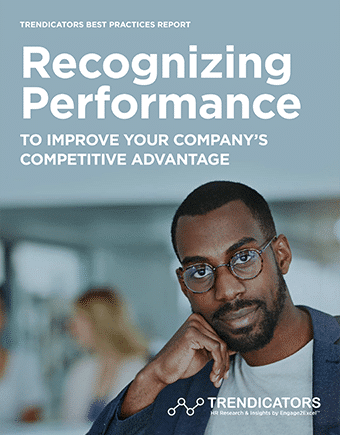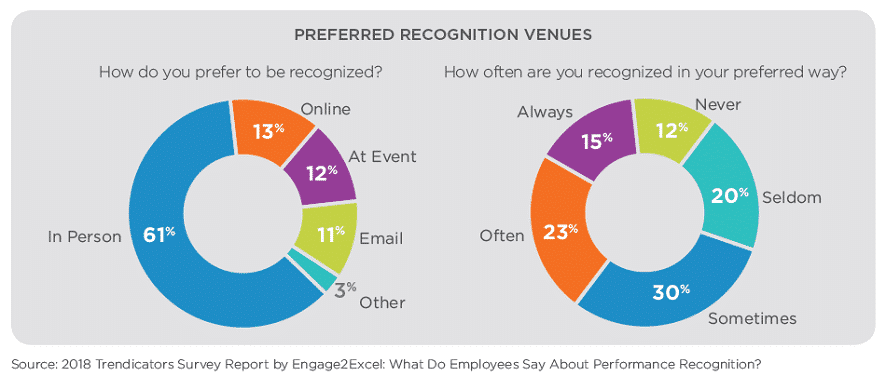Recognizing Performance

Effective performance recognition
requires creating a culture that acknowledges
and rewards behaviors that align with
organizational goals and objectives.
INTRODUCTION: HOW AND WHY PERFORMANCE RECOGNITION WORKS
Companies that nurture and sustain a vibrant culture of continuous enterprise-wide employee recognition outperform competitors that fail to leverage recognition to reinforce desired behaviors. There’s no mistaking the connection between a performance-driven recognition environment and high scores on key metrics, like employee engagement and retention, customer satisfaction, productivity, cost savings and shareholder return on equity. Recognition done right and a culture of appreciation effectively communicated from the top down fuel the accomplishment of enterprise goals and objectives.
It’s human nature to want to feel valued and appreciated. When an organization communicates recognition for a job well done, employees gain a tangible sense of how their efforts correlate with company results, and employees feel empowered to make a measurable difference. When workers are recognized for achieving business goals and see the positive impact of their contributions, workers are inclined to want to do more.
In addition to driving outcomes, performance recognition influences recruitment and retention success. Our survey of active and passive candidates revealed that lack of recognition was the number one reason why employees would consider accepting another job offer.
Source: 2017 Trendicators Survey Report by Engage2Excel:
What You Need To Know About Today’s Job Seekers
Download
 hbspt.cta.load(123973, '4878daed-4cd4-4f80-b547-7440dd15e382', {});
hbspt.cta.load(123973, '4878daed-4cd4-4f80-b547-7440dd15e382', {});
DETERMINING PROGRAM OBJECTIVES
Recognition plays a critical role during periods of growth and opportunity—when employees are stretched thin trying to juggle multiple priorities—as well as when times are tough, in the midst of difficult competitive circumstances or a challenging business environment.
To ensure that a recognition program is effective, the most important guideline to apply is aligning results-based recognition with the business strategy.
Beyond making employees feel more valued, the very purpose of employee recognition is to consistently communicate, support and reinforce enterprise goals and objectives.
Make sure the organization’s strategic goals are reflected in the recognition program’s objectives. Recognition can be used to promote desired behaviors that dictate success, provide employees with a unified purpose and reward those who successfully address the challenges that are prioritized by senior management.
Follow these simple steps to get started:
- Pick initiatives that can be influenced by increased levels of discretionary effort by employees.
- Define the business strategy and goals, and establish an initial program budget.
- Determine how to motivate behavioral change among participating employees.
- Clearly communicate the objectives of the recognition program.
Tips: Select measurable goals and establish key indicators of success so you can document the return on investment (ROI). Identify the current state and improvement targets, which will generate the data required to document progress and business impact.

Download
 hbspt.cta.load(123973, '4878daed-4cd4-4f80-b547-7440dd15e382', {});
hbspt.cta.load(123973, '4878daed-4cd4-4f80-b547-7440dd15e382', {});
IDENTIFYING BEHAVIORS AND CHAMPIONS
As noted in Step 1, collecting and analyzing data is essential for documenting successful business outcomes. However, in our data-centric world, it is worth remembering that people create value and deliver excellence. Which job family or families most directly influence the metrics you are trying to impact with the recognition program? Study these job families to understand what makes the very best employees go above and beyond each day and build your program around these behaviors.
Members of highly competent and collaborative teams pursuing innovative initiatives will likely be the best candidates to generate enthusiasm for your new recognition program. You want employees to emulate high-performance behaviors. Who better to inspire peers and model the practices you want to replicate than those who consistently demonstrate the power of engagement? These high achievers are your champions. Once you have identified who can enable and support the program’s success, the next step is eliciting the help of these high performers in defining exactly what they do in their daily work that results in significant contributions to business success. This input validates the behavioral criteria you will establish for the recognition program.
Next, you will want to encourage additional stakeholders to participate. They include target populations of employees who are likely to benefit from the program. Give them an opportunity to adopt a mindset that motivates them to raise their hands, speak up, suggest ideas, take actions to solve problems and be part of the solution.
Download
 hbspt.cta.load(123973, '4878daed-4cd4-4f80-b547-7440dd15e382', {});
hbspt.cta.load(123973, '4878daed-4cd4-4f80-b547-7440dd15e382', {});

CREATING YOUR PROGRAM CHARTER
Building on the important foundational work you did in Steps 1 and 2, you are now prepared to establish the business case for your performance recognition program. In creating the program charter, you will want to provide answers to the following questions:
- Which specific enterprise goals does this program address?
- What behaviors does the program aim to reinforce?
- What metrics exist to benchmark performance improvement?
- How will success be measured?
- What is the business value/potential ROI of success?
- What level of investment is required (to achieve success)?
- What are the potential risks of not making the investment?
The program charter is your blueprint for success. We recommend creating a presentation deck using the previously listed questions at the top of each slide. Provide answers to each question in the form of three or four bullet points.
Once you have completed the program charter presentation deck, you are ready to socialize it with the stakeholders identified in Step 2. Getting feedback and buy-in from stakeholders and sponsorship from senior leadership is critical. Go through as many iterations as needed to ensure that you have solid support for the program.
You have now completed the third and final step in building the strategic framework of your recognition program.
Now it’s time to roll up your sleeves and design the program architecture.
Download
 hbspt.cta.load(123973, '4878daed-4cd4-4f80-b547-7440dd15e382', {});
hbspt.cta.load(123973, '4878daed-4cd4-4f80-b547-7440dd15e382', {});

DESIGNING YOUR PROGRAM
Armed with support for your program charter, you are now ready to begin designing how your performance recognition program will work. Unlike conventional employee recognition programs, successful performance recognition programs require a purpose-built platform. The platform should enable the design and delivery of customizable, targeted employee experiences that integrate recognition sources. Moreover, it must deliver across multiple communications venues, include a wide rage of reward redemption choices and facilitate ROI analysis to measure the impact on business outcomes.
Key Considerations for Choosing a Performance Recognition Platform
Brand Relevance: Your organization and culture are unique. Does the platform enable you to create customized branding and messaging for your program?
Recognition Sources: Make sure that your platform makes it easy for all of your recognition sources to deliver meaningful performance recognition experiences. This should include managers and supervisors, team leaders, employee peers and executive leadership.
Communications Venues: Will the platform enable you to scale your programs to reach your entire workforce with personalized solutions that engage employees online, offline, via mobile and through messenger-based apps?
Incentives and Rewards: Are you able to offer a wide range of incentives and rewards choices to appeal to the diverse interests of employees? Are you able to incorporate language requirements, regional and religious customs, and male/female preferences into a culturally relevant recognition infrastructure?
Performance Analytics: Does the platform provider enable you to track program success with analytics that document impact on business outcomes?
Tip: Cyber-focused tech companies, in particular, sometimes overlook the importance of on-the-spot recognition in a public forum in front of peers for employees who typically spend the majority of their workday online.
73% of employees say that performance feedback from other members of their team is as important as feedback from their manager.
Source: 2018 Trendicators Survey Report by Engage2Excel: Employees Sound Off on Goal Setting and Performance Feedback
Download
 hbspt.cta.load(123973, '4878daed-4cd4-4f80-b547-7440dd15e382', {});
hbspt.cta.load(123973, '4878daed-4cd4-4f80-b547-7440dd15e382', {});
ENGAGING EXECUTIVE SPONSORS
Before launching the new recognition initiative, gaining senior management buy-in and support for the program charter and design you developed in Steps 3 and 4 is critical.
Your program charter presentation deck will come in very handy during this stage. The presentation lays out the plan for what the program will accomplish and how the accomplishments will be measured.
We recommend adding a few slides with highlights about your program design to complete your executive briefing materials.
Now, who are the ideal executive sponsors for your program?
Many recognition programs roll out exclusively as HR initiatives. Although support from your CHRO is vital, getting other C-suite and line-of-business execs onboard is important to gain visibility and credibility for your program.
As part of this collaboration with enterprise executives, you will present the value of the targeted recognition solution and discuss
expectations and roles for the organization’s leadership and management teams.
- Leverage the global reach, influence and visibility of senior executives to promote the program across the organization.
- Reinforce the importance of ongoing commitment from executive sponsors to spearhead the initiative.
- Emphasize HR’s commitment to keeping senior management involved and informed throughout the recognition program lifecycle.
- Set dates for executive briefings to help navigate any obstacles that may arise after the program is implemented.
Once you have your executive sponsors committed, formalize expectations in writing and keep your sponsors aware of progress with periodic updates.
Download
 hbspt.cta.load(123973, '4878daed-4cd4-4f80-b547-7440dd15e382', {});
hbspt.cta.load(123973, '4878daed-4cd4-4f80-b547-7440dd15e382', {});

ROLLING OUT YOUR PROGRAM
In addition to engaging executive sponsors (Step 5) before launch, you will want to communicate program details to middle managers and other previously identified champions before rolling out the initiative to employees. Then, revisit your communications plan:
- Will your program communications ignite engagement on day one and sustain momentum throughout the duration of
the program? - Have you thought through options for maximizing program visibility with on-site posters and electronic notifications?
- Will you promote the program in other venues such as the employee intranet portal?
Once the program is introduced, the focus should shift to training all workforce populations who have been identified as enablers (givers) or high-performing role models (receivers) for the recognition initiative.
All participants should have a comprehensive understanding of the program’s goals and philosophy, why the program is an organizational priority, how the program works and expectations regarding their specific responsibilities related to program adoption, implementation and follow-up.
Offer concise training on program usage and guidelines. Also consider distributing quick reference cards with easy-to-follow instructions for your recognition givers.
Download
 hbspt.cta.load(123973, '4878daed-4cd4-4f80-b547-7440dd15e382', {});
hbspt.cta.load(123973, '4878daed-4cd4-4f80-b547-7440dd15e382', {});

SHARING RESULTS AND CELEBRATING SUCCESS
After implementing the program, diligently and consistently track all related activities.
- Monitor levels of recognition activity to ensure active program participation.
- Evaluate progress, and regularly report on predetermined metrics to demonstrate business impact.
- Broadly share recognition achievements across the organization.
Keeping individual preferences in mind, highlight recipients who accomplish and exceed goals using a variety of communication channels, including intranet, social media, department meetings etc.
After the program has been in place for an appropriate time (30/60/90 days), explore opportunities to enhance the recognition initiative, perhaps by adding new program components.
- Make program adjustments to keep employees delighted and feeling appreciated.
- Update your program charter with actual results in a report to executive stakeholders.
- Compile a list of lessons learned for your next program.
- Based on the results of this program, identify other business goals and objectives that would benefit from performance recognition.
Download
 hbspt.cta.load(123973, '4878daed-4cd4-4f80-b547-7440dd15e382', {});
hbspt.cta.load(123973, '4878daed-4cd4-4f80-b547-7440dd15e382', {});
